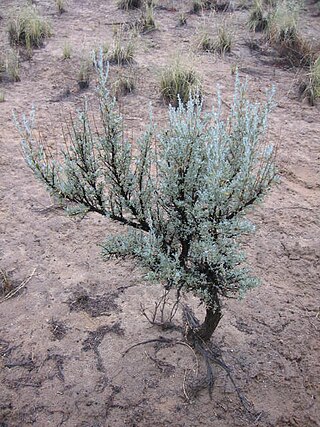
Thujone is a ketone and a monoterpene that occurs predominantly in two diastereomeric (epimeric) forms: (−)-α-thujone and (+)-β-thujone.

Terpenes are a class of natural products consisting of compounds with the formula (C5H8)n for n ≥ 2. Terpenes are major biosynthetic building blocks. Comprising more than 30,000 compounds, these unsaturated hydrocarbons are produced predominantly by plants, particularly conifers. In plants, terpenes and terpenoids are important mediators of ecological interactions, while some insects use some terpenes as a form of defense. Other functions of terpenoids include cell growth modulation and plant elongation, light harvesting and photoprotection, and membrane permeability and fluidity control.

Patchouli is a species of flowering plant in the family Lamiaceae, commonly called the mint or deadnettle family. The plant grows as a bushy perennial herb, with erect stems reaching up to 75 centimetres (30 in) in height and bearing small, pale, pink-white flowers.

Cannabis sativa is an annual herbaceous flowering plant. The species was first classified by Carl Linnaeus in 1753. The specific epithet sativa means 'cultivated'. Indigenous to Eastern Asia, the plant is now of cosmopolitan distribution due to widespread cultivation. It has been cultivated throughout recorded history and used as a source of industrial fiber, seed oil, food, and medicine. It is also used as a recreational drug and for religious and spiritual purposes.

Linalool refers to two enantiomers of a naturally occurring terpene alcohol found in many flowers and spice plants. Together with geraniol, nerol, citronellol, linalool is one of the rose alcohols. Linalool has multiple commercial applications, the majority of which are based on its pleasant scent.

Farnesol is a natural 15-carbon organic compound which is an acyclic sesquiterpene alcohol. Under standard conditions, it is a colorless liquid. It is hydrophobic, and thus insoluble in water, but miscible with oils. As the pyrophosphate ester, farnesol is a precursor to many terpenes and terpenoids.

The term farnesene refers to a set of six closely related chemical compounds which all are sesquiterpenes. α-Farnesene and β-farnesene are isomers, differing by the location of one double bond. α-Farnesene is 3,7,11-trimethyl-1,3,6,10-dodecatetraene and β-farnesene is 7,11-dimethyl-3-methylene-1,6,10-dodecatriene. The alpha form can exist as four stereoisomers that differ about the geometry of two of its three internal double bonds. The beta isomer exists as two stereoisomers about the geometry of its central double bond.

Prenol, or 3-methyl-2-buten-1-ol, is a natural alcohol. It is one of the most simple terpenoids. It is a clear colorless oil that is reasonably soluble in water and miscible with most common organic solvents. It has a fruity odor and is used occasionally in perfumery.
Farnesyl pyrophosphate (FPP), also known as farnesyl diphosphate (FDP), is an intermediate in the biosynthesis of terpenes and terpenoids such as sterols and carotenoids. It is also used in the synthesis of CoQ, as well as dehydrodolichol diphosphate.

Sesquiterpenes are a class of terpenes that consist of three isoprene units and often have the molecular formula C15H24. Like monoterpenes, sesquiterpenes may be cyclic or contain rings, including many unique combinations. Biochemical modifications such as oxidation or rearrangement produce the related sesquiterpenoids. A recent study conducted in the Cosmics Leaving Outdoor Droplets large cloud chamber at CERN, has identified sesquiterpenes—gaseous hydrocarbons that are released by plants—as potentially playing a major role in cloud formation in relatively pristine regions of the atmosphere.
Monoterpenes are a class of terpenes that consist of two isoprene units and have the molecular formula C10H16. Monoterpenes may be linear (acyclic) or contain rings (monocyclic and bicyclic). Modified terpenes, such as those containing oxygen functionality or missing a methyl group, are called monoterpenoids. Monoterpenes and monoterpenoids are diverse. They have relevance to the pharmaceutical, cosmetic, agricultural, and food industries.

Cannabis flower essential oil, also known as hemp essential oil, is an essential oil obtained by steam distillation from the flowers, panicles, stem, and upper leaves of the hemp plant. Hemp essential oil is distinct from hemp seed oil and hash oil: the former is a vegetable oil that is cold-pressed from the seeds of low-THC varieties of hemp, the latter is a THC-rich extract of dried female hemp flowers (marijuana) or resin (hashish).
The enzyme (+)-δ-cadinene synthase catalyzes the chemical reaction
The enzyme amorpha-4,11-diene synthase (ADS) catalyzes the chemical reaction

Artemisia pallens, dhavanam from the Sanskrit name दमनक (damanaka),(Tamil: மரிக்கொழுந்து, தவணம், Marathi: दवणा, Kannada: ದವನ), is an aromatic herb, In genus of small herbs or shrubs, xerophytic In nature. The flowers are racemose panicles, bear numerous small yellow flower heads or capitula, but the silvery white silky covering of down gives the foliage a grey or white appearance.

Absinthin is a naturally produced triterpene lactone from the plant Artemisia absinthium (Wormwood). It constitutes one of the most bitter chemical agents responsible for absinthe's distinct taste. The compound shows biological activity and has shown promise as an anti-inflammatory agent, and should not be confused with thujone, a neurotoxin also found in Artemisia absinthium.
β-Farnesene synthase (EC 4.2.3.47, farnesene synthase, terpene synthase 10, terpene synthase 10-B73, TPS10) is an enzyme with systematic name (2E,6E)-farnesyl-diphosphate diphosphate-lyase ((E)-β-farnesene-forming). This enzyme catalyses the following chemical reaction
(3R,6E)-nerolidol synthase (EC 4.2.3.49, terpene synthase 1) is an enzyme with systematic name (2E,6E)-farnesyl-diphosphate diphosphate-lyase ((3R,6E)-nerolidol-forming). This enzyme catalyses the following chemical reaction
(−)-δ-Cadinene synthase is an enzyme with systematic name (2E,6E)-farnesyl-diphosphate diphosphate-lyase . This enzyme catalyses the following chemical reaction
Geranylacetone is an organic compound with the formula CH3C(O)(CH2)2CH=C(CH3)(CH2)2CH=C(CH3)2. A colorless oil, it is the product of coupling geranyl and acetonyl groups. It is a precursor to synthetic squalene.













